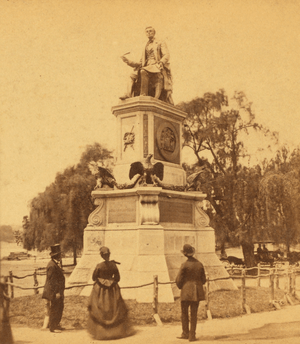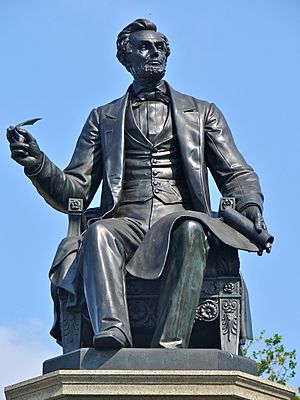Lincoln Monument (Philadelphia) facts for kids

Lincoln Monument, in the 1870s
|
|
| Coordinates | 39°58′10.56″N 75°11′4.02″W / 39.9696000°N 75.1844500°W |
|---|---|
| Location | Kelly Drive & Sedgley Drive, Fairmount Park, Philadelphia |
| Designer | Randolph Rogers |
| Material | Sculpture: bronze Base: granite & bronze |
| Length | 17 ft (5.2 m) |
| Width | 15 ft (4.6 m) |
| Height | Overall: 32 ft (9.8 m) Sculpture: 8.67 ft (2.64 m) |
| Beginning date | Commissioned 1866 Cast 1870 |
| City of Philadelphia Fairmount Park Commission |
|
The Lincoln Monument in Philadelphia, Pennsylvania, is a special statue honoring Abraham Lincoln. He was the 16th President of the United States. This monument was one of the first built after President Lincoln was sadly assassinated.
The famous sculptor Randolph Rogers designed it. It was finished in 1871. Today, you can find this important monument in Fairmount Park. It is located near Kelly Drive and Sedgley Drive, across from Boathouse Row.
Contents
What the Lincoln Monument Looks Like
The main part of the monument is a large bronze statue. It shows Abraham Lincoln sitting down. He is holding a pen in one hand and the Emancipation Proclamation in the other. This document declared millions of enslaved people free. The statue is called Lincoln the Emancipator.
The statue is about 8.67 feet (2.64 meters) tall. It is also about 4 feet (1.2 meters) wide and 8 feet (2.4 meters) long. It was created by Randolph Rogers in Rome, Italy.
The statue sits on a tall base made of granite. This base has three main parts. The top part has four bronze plaques. These plaques show symbols like crossed American flags and the Great Seal of the United States. At each corner, bronze eagles sit on granite scrolls.
The middle part of the base has important words carved into it. These words include the monument's dedication. You can also read famous quotes from the Emancipation Proclamation. There are also lines from Lincoln's Gettysburg Address and his Second Inaugural Address. The bottom part of the base is rough and sloped. The entire base is about 23.5 feet (7.16 meters) tall.
The bronze statue and other bronze parts were made in Munich, Germany. This happened in 1870. A Philadelphia company called Struthers & Sons built the granite base.
How the Monument Was Built
Starting the Monument Idea
President Lincoln was assassinated on April 15, 1865. Soon after, on May 22, a group in Philadelphia formed the Lincoln Monument Association. This group wanted to create a monument to honor the late president.
The mayor of Philadelphia, Alexander Henry, led this group. They quickly raised $22,000. This money was used to pay for the monument. Many American sculptors were asked to submit their ideas. They had to show two models: one of Lincoln standing, and another with Lincoln and an allegorical figure. Only two sculptors, Thomas Ball and Randolph Rogers, sent in models.
Randolph Rogers did not follow all the rules. His first idea was a seated Lincoln. His second idea showed Lincoln helping an enslaved woman rise. Rogers explained his seated Lincoln idea. He said it showed Lincoln signing the Emancipation Proclamation. He wanted Lincoln to be looking to heaven, asking for God's approval. Rogers felt this was the most important moment of Lincoln's life.
The Association chose the seated Lincoln statue. Randolph Rogers was given the job in 1866. Rogers was an American artist who lived and trained mostly in Italy. He also created the Columbus Doors for the United States Capitol. He worked on several other important monuments during this time. These included monuments for the American Civil War.
The Dedication Ceremony in 1871
The Lincoln Monument was placed in Fairmount Park. It was put on a grassy traffic circle. The dedication ceremony happened on September 22, 1871. This date was special because it was the anniversary of Lincoln's first Emancipation Proclamation.
A large crowd of 50,000 people came to the event. Many important people were invited. These included government officials and military groups. President Ulysses S. Grant was invited but could not attend.
The main speech was given by Col. William McMichael. He was a former military aide to General Grant. McMichael talked about Lincoln's life and the Civil War. He also mentioned Lincoln's funeral in Philadelphia. He ended his speech with a quote from the Gettysburg Address.
Randolph Rogers, the sculptor, came all the way from Italy for the event. He was recognized during the ceremony. After the dedication, there was a big military parade.
Where It Is Today
In January 2002, the Lincoln Monument was moved. It was shifted about 100 feet (30 meters) to the north side of Kelly Drive. The traffic circle where it used to be was removed.
Inscriptions on the Monument
The monument has important words carved into its granite base. These are found on plaques in the middle section.
- East (front) side:
ABRAHAM LINCOLN
- South (left) side: (From the Emancipation Proclamation)
THAT ALL PERSONS HELD
AS SLAVES WITHIN THE STATES
- West (back) side: (From the Gettysburg Address)
THAT THE GOVERNMENT OF THE PEOPLE
BY THE PEOPLE
AND FOR THE PEOPLE
- North (right) side: (From Lincoln's Second Inaugural Address)
WITH CHARITY TOWARD ALL
WITH FIRMNESS IN THE RIGHT
AS GOD GIVES US TO SEE THE RIGHT,


